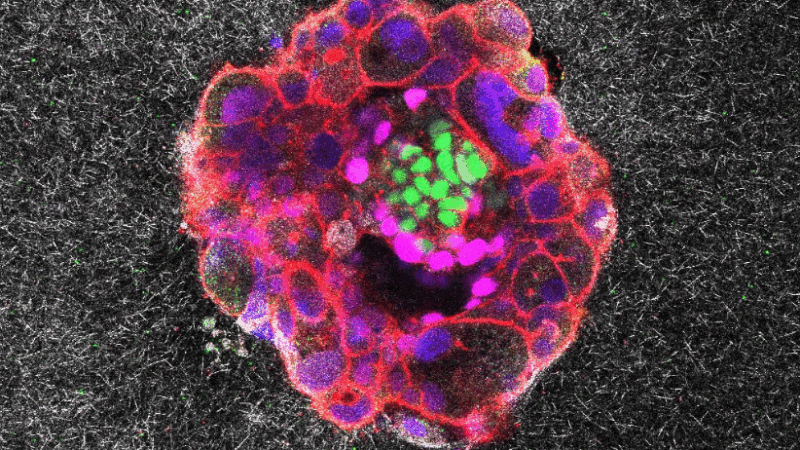Embryos small but mighty, first live videos show
For the first time, scientists have recorded a human embryo implanting into a womb in real time, a feat the researchers hope will lead to new ways to treat infertility and prevent miscarriages.
“Being able to record a movie of something that has never been seen before, which are the early steps of life — of human life – was mind-blowing,” says Samuel Ojosnegros, head of bioengineering in reproductive health at the Institute for Bioengineering of Catalonia in Spain. “It was really, really exciting.”
One of the most important steps in an embryo’s journey to becoming a baby is when the microscopic ball of cells implants in the uterus. But how a human embryo implants in the womb has long been a mystery.
“We just can’t see it because it happens inside the uterus hidden from scientific experimentation,” he says.
So Ojosnegros and his colleagues created an artificial womb in a dish in their lab – a gel, or matrix, made of collagen, a protein found in the womb and elsewhere in the body. The scientists then placed into the womb dozens of human embryos, which were left over from infertility treatments. As the embryos settled in overnight, the researchers recorded time-lapse videos with a microscope.
That enabled the scientists to clearly see and analyze the embryos as they burrowed into the uterus to find a good spot to continue developing.
“We can see how the embryo penetrates this matrix and sort of digs a hole in the matrix. It’s very, very beautiful. And it’s very, very surprising because we knew that the embryo had to do something like that, but it had never been recorded how they do it,” he says. “It’s quite stunning to see it live.”
That enabled the research team to start to understand how a human embryo uses enzymes to separate and penetrate the fibers in the matrix to force themselves into the uterus.
“You could imagine that the embryo sends little fingers or little arms into this matrix and that can pull this embryo deeper and deeper in our matrix,” says Amelie Godeau, a graduate student who helped conduct the experiment with Anna Seriola and others.

The scientists were surprised by how forceful human embryos are, especially compared to mouse embryos, which appear to lie passively as a womb envelopes them.
“The most surprising thing is those two things: How the embryo is capable of penetrating the matrix. And how the embryo exerts a lot of force,” Ojosnegros says.
The amount of power the embryos exert could explain a phenomenon many pregnant women know well – commonly known as “implantation cramps,” the researchers say.
“Many women report this kind of itching or so at the moment where an embryo could be implanting,” Godeau says. “It can explain these implantation cramps that women are feeling when the embryo implants.”
The researchers hope these experiments will help discover why implantation fails, a major cause of infertility and miscarriages. About two-thirds of embryos either fail to implant or are lost soon after implantation, the researchers say.
“Implantation is the main roadblock of human infertility, by far. It’s the main cause,” Ojosnegros says.
Other researchers praised the research, which was published in the journal Science Advances.
“This is an amazing body of work. This is a big deal,” says Amy Sparks, director of in vitro fertilization and reproductive testing laboratories at the University of Iowa and a vice president at the American Society for Reproductive Medicine.
“I’m very excited to see this study,” agrees Magdalena Zernicka-Goetz, who studies human embryos at the California Institute of Technology. “It really takes a major step towards opening one of the black boxes of human development. It’s beautiful.”
Chinese military stages drills around Taiwan to warn ‘external forces’
The drills came after Beijing expressed anger at U.S. arms sales, and a statement by Japan's prime minister saying its military could get involved if China were to take action against Taiwan.
Trump and Netanyahu to meet in Florida at a crucial moment for the Gaza ceasefire
President Trump could use the face-to-face at his Mar-a-Lago estate to look for ways to speed up the peace process, as Israel's leader has been accused of not pushing his side to move fast enough.
‘Bomb cyclone’ forecasted to bring heavy snow, blizzard conditions and dangerous travel
A 'bomb cyclone' is intensifying severe winter weather for millions of people across the U.S. The system is expected to knock out power and disrupt holiday travel.
Russia sends 3 Iranian satellites into orbit, report says
The report said that a Russian rocket sent the satellites on Sunday from a launchpad in eastern Russia.
Viral global TikToks: A twist on soccer, Tanzania’s Charlie Chaplin, hope in Gaza
TikToks are everywhere (well, except countries like Australia and India, where they've been banned.) We talk to the creators of some of the year's most popular reels from the Global South.
This painting is missing. Do you have it?
An important work from a rediscovered artist has been absent from public view since the 1970s. A New York curator is hunting for it.








